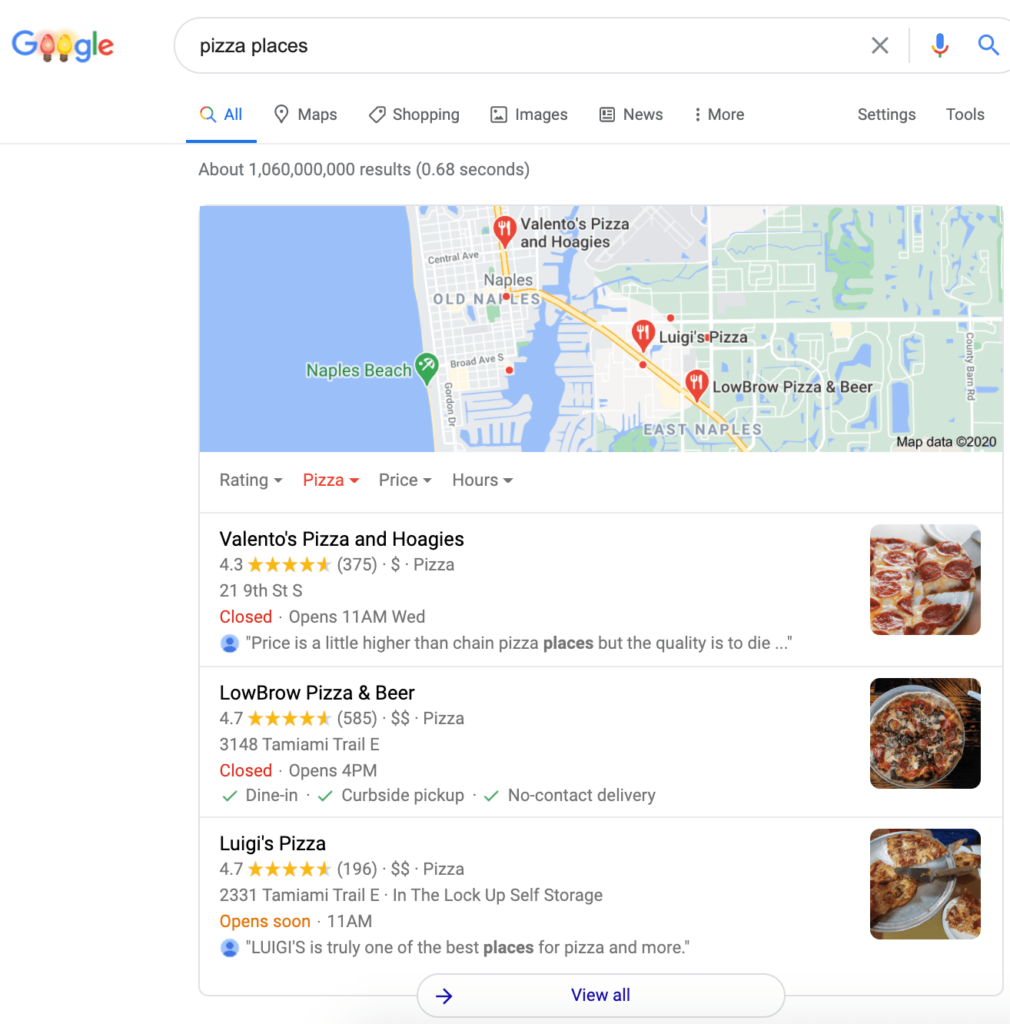
Many businesses aim for their websites to rank highly in search engines, but it’s a moving target.
In fact, Google released 8 notable algorithm updates this year so far to better meet searchers’ needs (emphasizing the “optimization” part of SEO).
You might remember when Google’s featured snippet addition disrupted the numbered ranking system of search pages. Because the snippet’s goal is to provide a simple answer from a strong piece of content, it might pull from the second or fourth website listed on the search engine result page instead of the first.
As a result, 34% of desktop users don’t even click on a webpage, since their questions are answered by a featured snippet on the search results page. This may seem like a cheap tactic to hoard traffic, but it’s not. By prioritizing the searcher’s experience over the hierarchy of web pages, Google ensures satisfied users.
Optimizing for search engines shouldn’t be your main focus anymore. The ongoing shift in Google’s algorithm over the past decade indicates a new market focus on meeting user expectations. In this post, I’ll do my best to pull back the curtain and show you how improving the user experience on your site will also improve your rankings and increase traffic.
Search Engine Engagement Metrics
Before we delve deeper into the metrics that will likely correlate with an increase in rankings in the age of user experience, it’s worth noting that no search engine is an open book. Google notifies the public when it updates its core algorithm, but it’s notoriously secretive about this proprietary information.
With this in mind, here are a few user engagement metrics that Google and other engines seem to value as priorities.
Mobile Optimization
In 2015, Google announced that mobile optimization would become a contributing factor to SEO rankings. Half of all searches originate on mobile devices, after all.
Google recommends a responsive web design that adapts to desktop computers, phones, and tablets, and it rewards mobile-optimized sites with higher rankings on SERPs.
This opens up into another potential benefit: placement in Google’s coveted “local pack.” The local pack is the set of three businesses featured on Google’s search results. Previously, Google featured seven businesses there, but the number has since been reduced to maintain a mobile-friendly layout.

Semantic Search
We’ve already mentioned that Google’s algorithm has drastically changed, especially since the old days of keyword stuffing. The first change allowed Google to judge not only the use of keywords, but also the ways in which they are used. During this phase, keywords and phrases needed to appear naturally. If they detracted from the readability of a page, Google would penalize that page’s ranking.
After the 2013 Hummingbird update, the search engine’s algorithm considers overall meaning — it realizes a page is more than the sum of its keywords. For instance, if you searched for “What’s the fastest animal?” prior to Hummingbird, a page would have to use the keywords “fastest animal” in several places to communicate the topic to Google’s crawlers. Now, with semantic search, Google can compare search intent with a page’s content to provide a better search experience.
Most recently, Google has helped searchers by rolling out BERT. This technology was designed for users who increasingly search by posing questions. It considers search intent by analyzing how a word relates contextually to the words that precede and follow it. Most searches made via voice recognition are questions, so this advancement will probably benefit Google in the future, especially around the holiday season when voice enabled devices are on everyone’s gift list.
Dwell Time
The dwell time metric is determined by the amount of time a user spends on a page before navigating back to a search engine. Search engines use this metric to judge the relevance of a page to a user’s query. If a user stays on a page for a long time before bouncing back to the SERP, then that page is likely more valuable than others.
Browsers such as Google Chrome, which is used by 81% of W3School’s 50 million monthly visitors as of August 2021, know how long a visitor remains on a page. Dwell time is a significant indicator of relevancy and quality, so webpage designers should aim for visitors to remain on a website for as long as possible.
Unfortunately, dwell time is one of many metrics that only search engines have access to. However, you can still use other data to measure the user engagement on your own site. Tracking metrics like time on page, bounce rate, and conversions from your landing pages can provide crucial insights into the value your users get from their experiences with your website.
4 Ways to Boost User Engagement on Your Website
Realistically, it’s easy to understand how a great user interface has the potential to boost search rankings, but making it happen is another story. Let’s take a look at several UX SEO techniques:
1. Augmented Reality (AR)
Personal care and beauty store Sephora released its AR tool, Visual Artist, a few years ago and continues to improve the user experience. Users can virtually try on lipsticks, lashes, eyeshadows, and other cosmetic products from the comfort of their homes. This small user experience-focused change resulted in a reported organic revenue growth of 14% parent company LVMH.
Augmented reality is increasingly accessible to smaller businesses. It is quite common to find eyeglass retail websites, for instance, boosting user engagement with AR features that allow shoppers to virtually try on glasses.
You can also use this technology to include customers in the experience of launching a product. Jordan Brand did just that with the release of its Air Jordan III Tinker sneakers. Sneaker fans could scan a Snapchat code, purchase through Shopify, and have the shoes delivered by local fulfillment centers within the day.
2. Interactive Tools
Increasing user engagement is as simple as finding ways to capture the attention of a website visitor. Interactive tools and activities that occupy a user’s time (and provide value) are essential when creating a top-notch search experience.
This could be something simple such as a mortgage cost calculator on a home lending website, a responsive chatbot, or live user survey feature on your landing page. Warby Parker, for example, has enhanced the online prescription glasses retail web experience by offering an online quiz for picking out the right frames. The simple quiz provides personalized fashion advice and leads visitors along their sales journeys.

In fact, if you use a tool like SEMrush to identify the most trafficked pages of a popular website, you will often find that they are interactive. These tools keep users engaged. By installing event tracking within the tools, Google Analytics can report just how engaging they are.
3. Video Content
Many marketers fear that video content will slow down their pages and cause the bounce rate to skyrocket. This is a valid concern, but it also may be worth the risk. Video is easier for people to process, and it can encourage someone to stay 2.6 times longer on a webpage. Well-placed video enhances dwell time and boosts rankings.
For example, Toyota used video in its interactive “Choose Your Wild” campaign for its 4Runner vehicle. The video engages potential customers by letting them go virtually “off-road” in the vehicle and, at the same time, allows the company to collect customer preference information in a fun, unobtrusive way.
4. Lead Magnets
Surprisingly, some of the most effective ways to ensure you’re providing an exceptional user experience aren’t particularly innovative at all. Lead magnets with gated content aren’t a new tool in the digital marketing space, but you’ll find that you’ll command your audience well by understanding their needs and producing applicable content.
After all, the subtext of Google’s movement toward user-friendly webpages is really just ensuring that high-ranking pages are valuable content resources. You will be improving the user experience and prioritizing conversion optimization at the same time.
Bidsketch uses this approach: It offers a free sample proposal in exchange for a voluntarily disclosed customer email address. Content-heavy websites like The Oatmeal and BuzzFeed similarly capture email addresses by offering quizzes (which also enhance user engagement and dwell time). Try offering various free “goodies” as lead magnets such as spreadsheets, tutorials, generators, or calculators.
By keeping users engaged with valuable, meaningful content, you will not only create happier visitors (and maybe brand advocates), but you will also rank highly on Google.
Whether that engagement stems from augmented reality, interactivity, videos, lead magnets, or some other approach, it can make all the difference in the success of a company’s user experience and SEO efforts.
This article was originally published on Hubspot